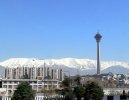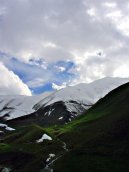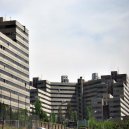| Introduction - Iran: |
| Location - Iran: |
| People - Iran: |
| Government - Iran: |
| Economy - Iran: |
Economy overview | Irans economy is marked by a bloated, inefficient state sector, over reliance on the oil sector, and statist policies that create major distortions throughout. Most economic activity is controlled by the state. Private sector activity is typically small-scale workshops, farming, and services. President Mahmud AHMADI-NEJAD has continued to follow the market reform plans of former President RAFSANJANI, with limited progress. Relatively high oil prices in recent years have enabled Iran to amass nearly $60 billion in foreign exchange reserves, but have not eased economic hardships such as high unemployment and inflation. The proportion of the economy devoted to the development of weapons of mass destruction remains a contentious issue with leading Western nations. |
|
Gdp purchasing power parity | $599.2 billion (2006 est.) |
|
Gdp official exchange rate | $193.5 billion (2006 est.) |
|
Gdp real growth rate | 4.3% (2006 est.) |
|
Gdp per capita ppp | $8,700 (2006 est.) |
|
Gdp composition by sector | agriculture: 11.2%
industry: 41.7%
services: 47.1% (2006 est.) |
|
Labor force | 24.36 million
note: shortage of skilled labor (2006 est.) |
|
Labor force by occupation | agriculture: 30%
industry: 25%
services: 45% (2001 est.) |
|
Unemployment rate | 15% according to the Iranian government (2007 est.) |
|
Population below poverty line | 40% (2002 est.) |
|
Household income or consumption by percentage share | lowest 10%: NA%
highest 10%: NA% |
|
Distribution of family income gini index | 43 (1998) |
|
Inflation rate consumer prices | 15.8% (2006 est.) |
|
Investment gross fixed | 30% of GDP (2006 est.) |
|
Budget | revenues: $104.6 billion
expenditures: $100.6 billion; including capital expenditures of $7.6 billion (2006 est.) |
|
Public debt | 25.3% of GDP (2006 est.) |
|
Agriculture products | wheat, rice, other grains, sugar beets, fruits, nuts, cotton; dairy products, wool; caviar |
|
Industries | petroleum, petrochemicals, fertilizers, caustic soda, textiles, cement and other construction materials, food processing (particularly sugar refining and vegetable oil production), ferrous and non-ferrous metal fabrication, armaments |
|
Industrial production growth rate | 3.2% excluding oil (2006 est.) |
|
Electricity production | 155.7 billion kWh (2004) |
|
Electricity consumption | 145.1 billion kWh (2004) |
|
Electricity exports | 1.837 billion kWh (2004) |
|
Electricity imports | 2.17 billion kWh (2004) |
|
Oil production | 3.979 million bbl/day (2005 est.) |
|
Oil consumption | 1.51 million bbl/day (2004 est.) |
|
Oil exports | 2.836 million bbl/day (2004 est.) |
|
Oil imports | NA bbl/day |
|
Oil proved reserves | 132.5 billion bbl based on Iranian claims (2006 est.) |
|
Natural gas production | 83.9 billion cu m (2004 est.) |
|
Natural gas consumption | 85.54 billion cu m (2004 est.) |
|
Natural gas exports | 3.56 billion cu m (2004 est.) |
|
Natural gas imports | 5.2 billion cu m (2004 est.) |
|
Natural gas proved reserves | 26.62 trillion cu m (1 January 2005 est.) |
|
Current account balance | $13.13 billion (2006 est.) |
|
Exports | $63.18 billion f.o.b. (2006 est.) |
|
Exports commodities | petroleum 80%, chemical and petrochemical products, fruits and nuts, carpets |
|
Exports partners | Japan 14.1%, China 12.9%, Turkey 7.3%, Italy 6.3%, South Korea 5.7%, Netherlands 4.6%, Taiwan 4% (2006) |
|
Imports | $45.48 billion f.o.b. (2006 est.) |
|
Imports commodities | industrial raw materials and intermediate goods, capital goods, foodstuffs and other consumer goods, technical services, military supplies |
|
Imports partners | Germany 12.1%, China 10.6%, UAE 9.4%, South Korea 6.2%, France 5.6%, Italy 5.4%, Russia 4.5% (2006) |
|
Reserves of foreign exchange and gold | $58.46 billion (2006 est.) |
|
Debt external | $14.8 billion (2006 est.) |
|
Economic aid recipient | $408 million (2002 est.) |
|
Currency code | Iranian rial (IRR) |
|
Exchange rates | rials per US dollar - 9,227.1 (2006), 8,964 (2005), 8,614 (2004), 8,193.9 (2003), 6,907 (2002)
note: Iran has been using a managed floating exchange rate regime since unifying multiple exchange rates in March 2002 |
|
| Communications - Iran: |
| Transportation - Iran: |
| Military - Iran: |
This page was last updated on 16 September, 2007



